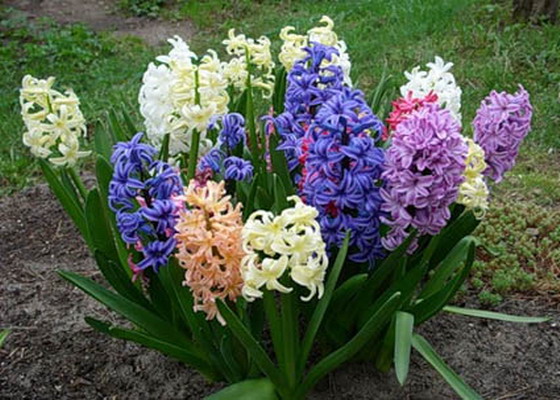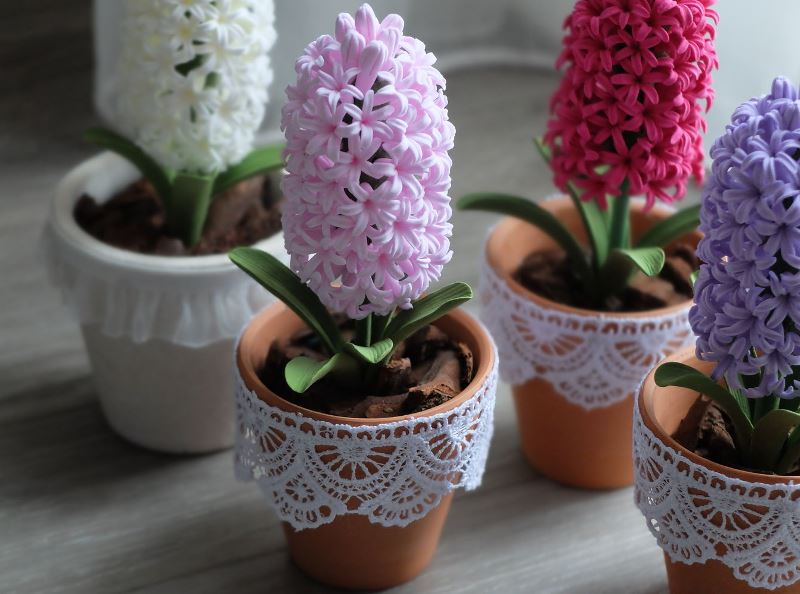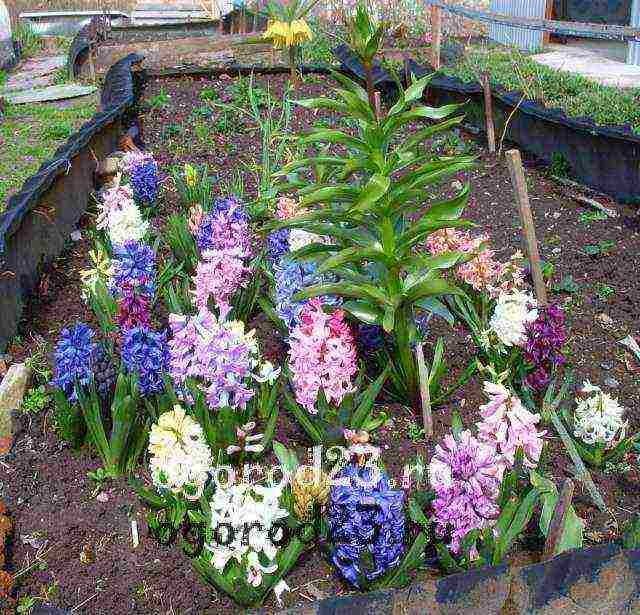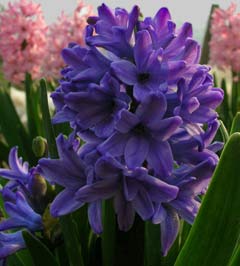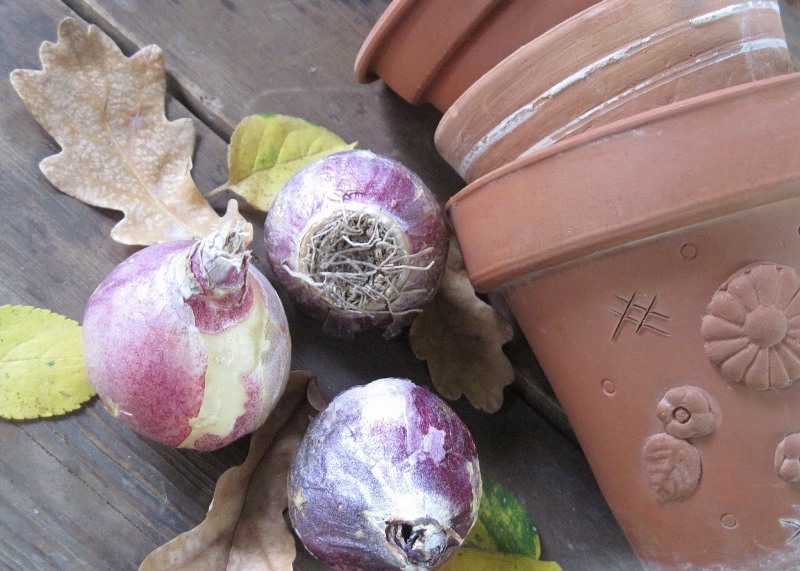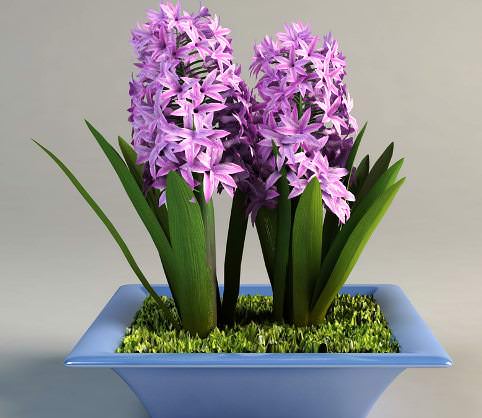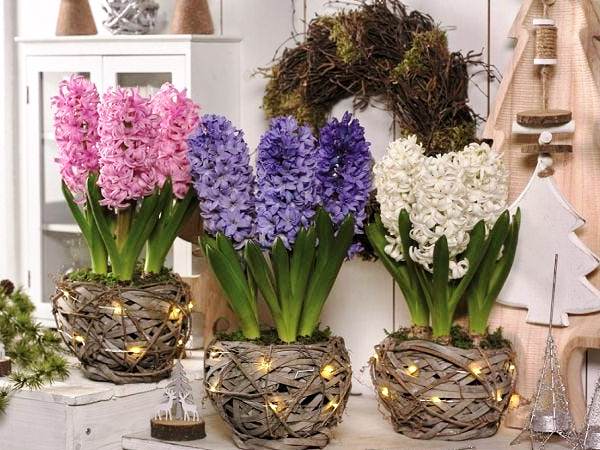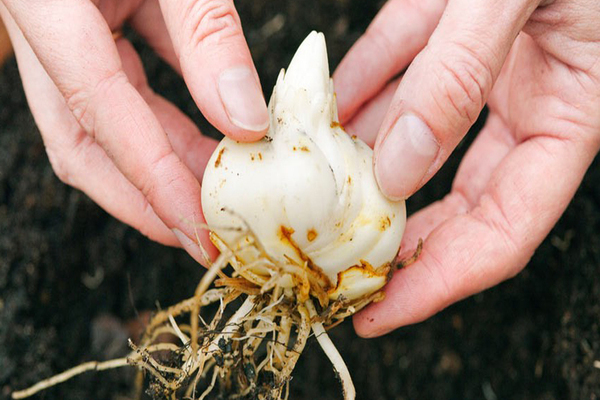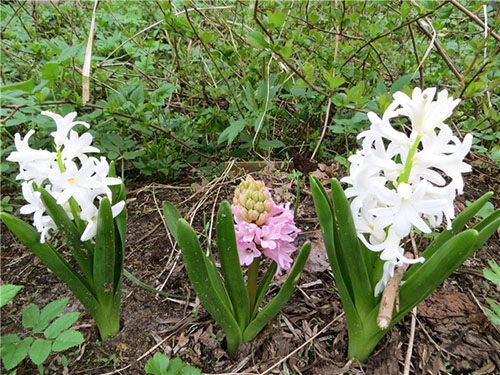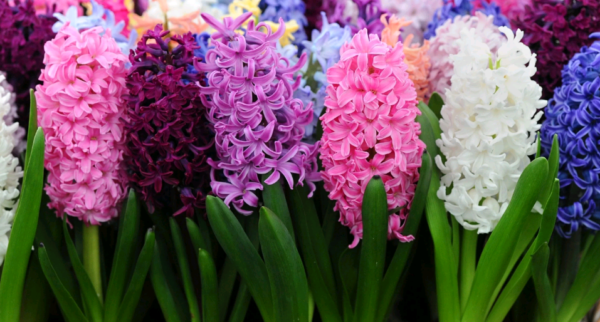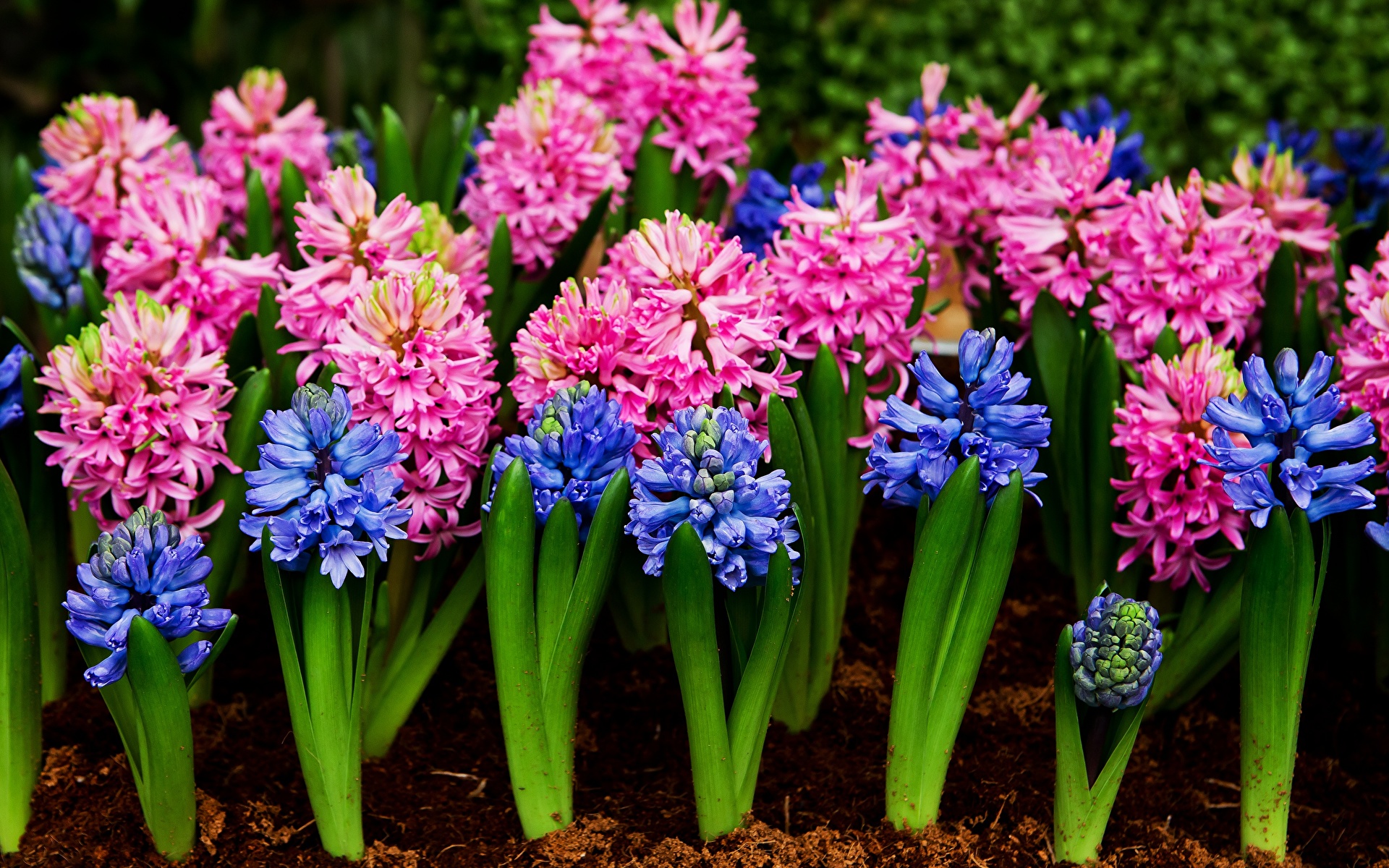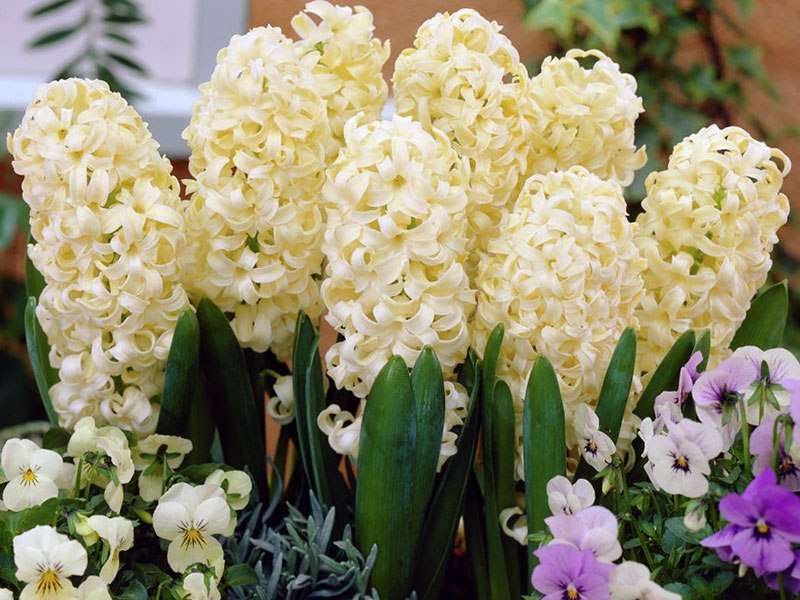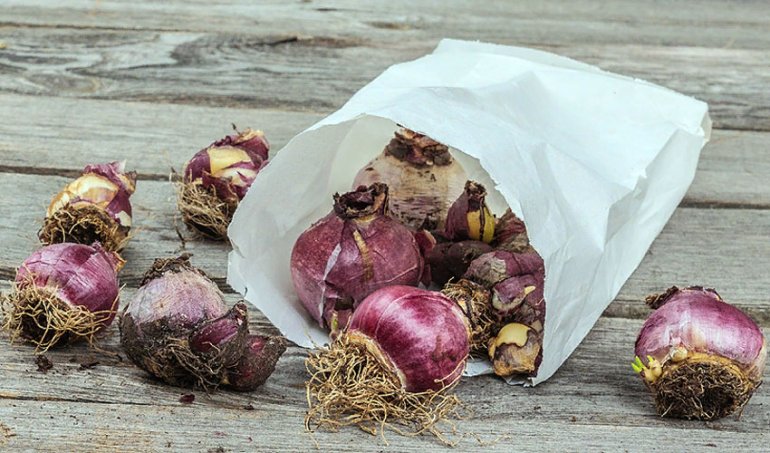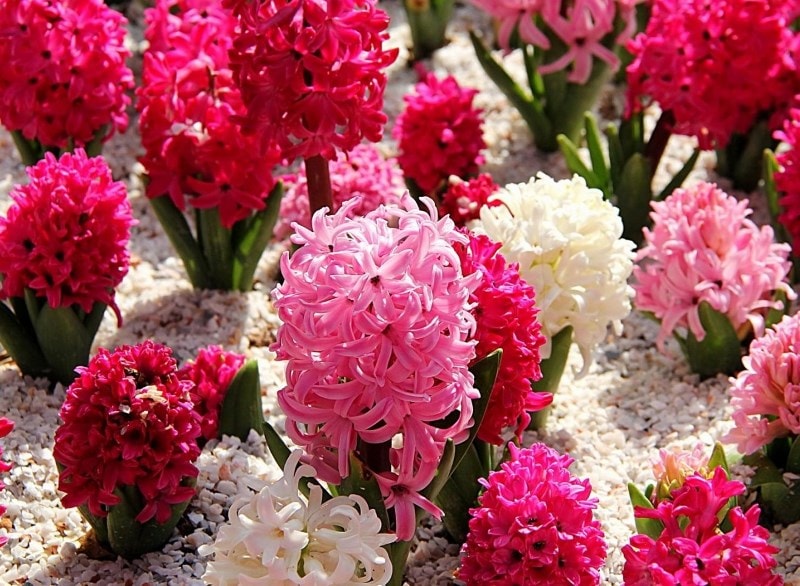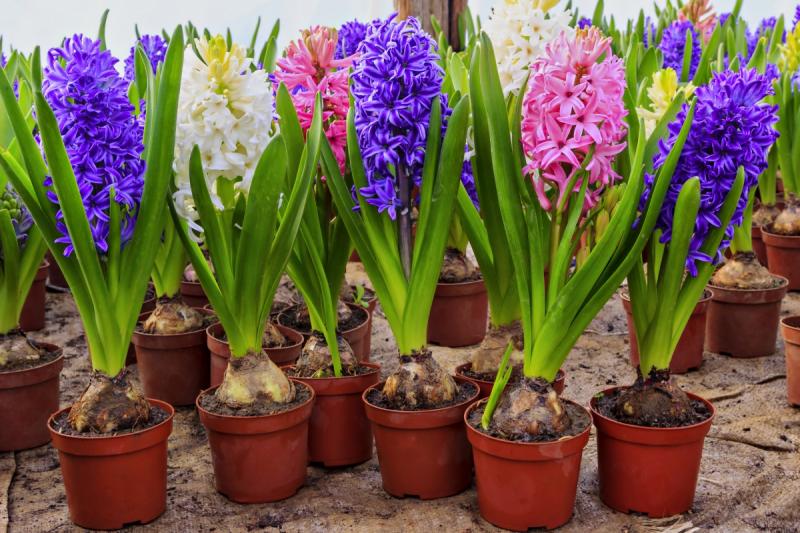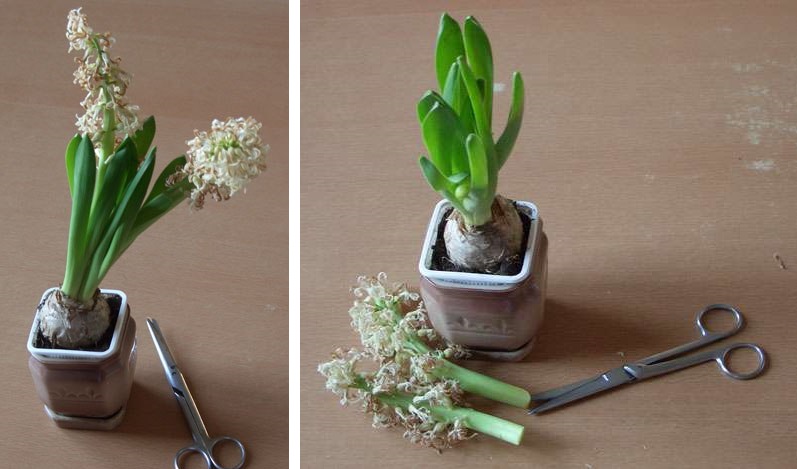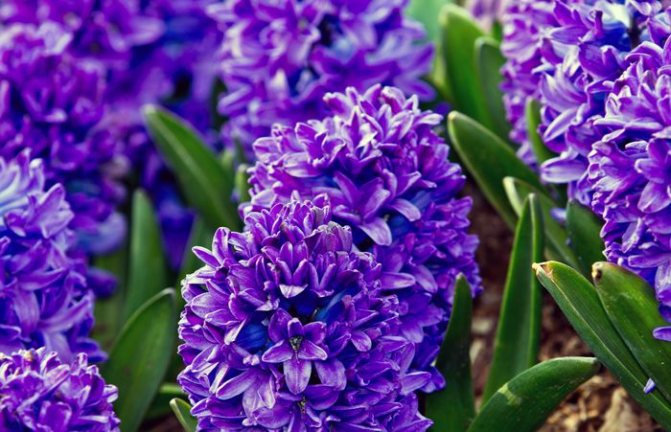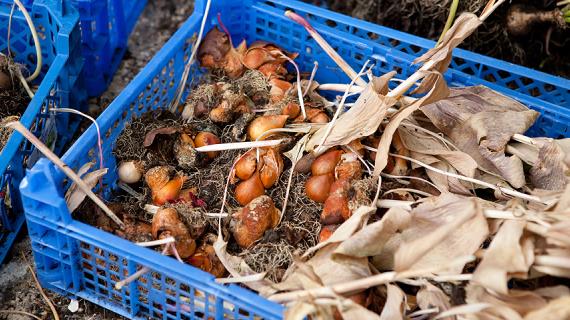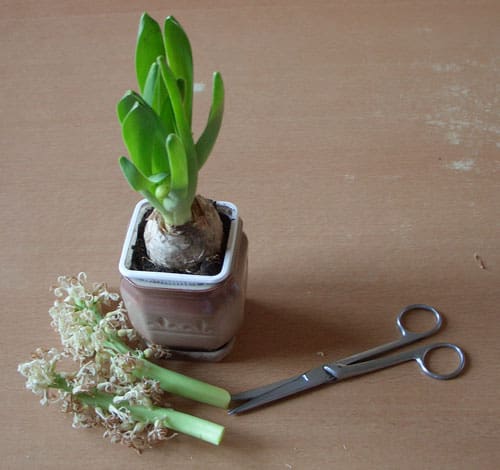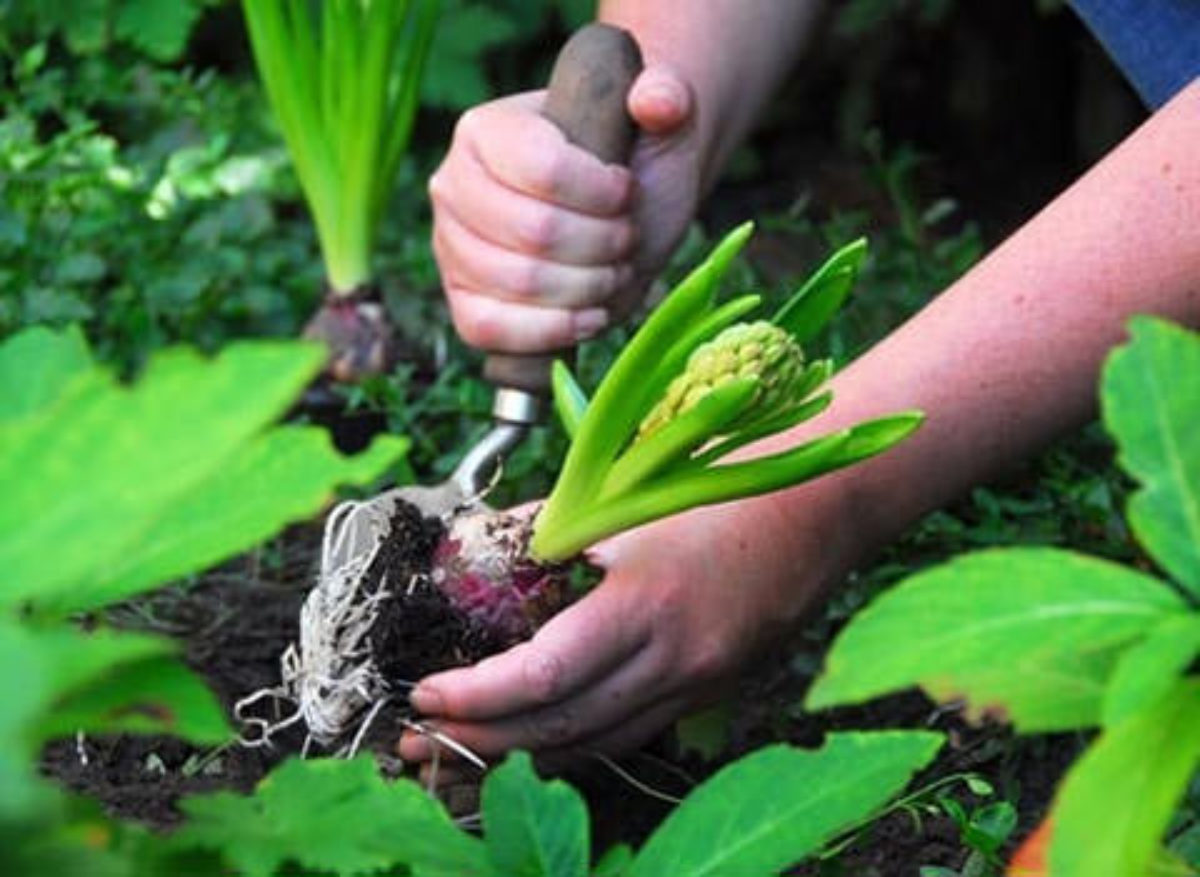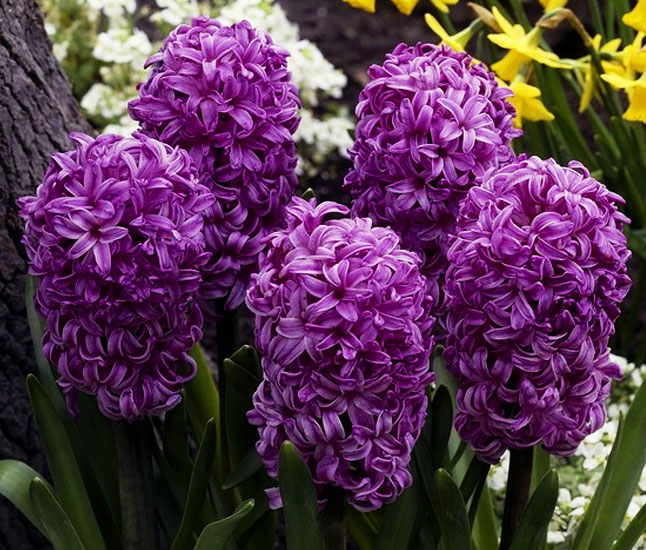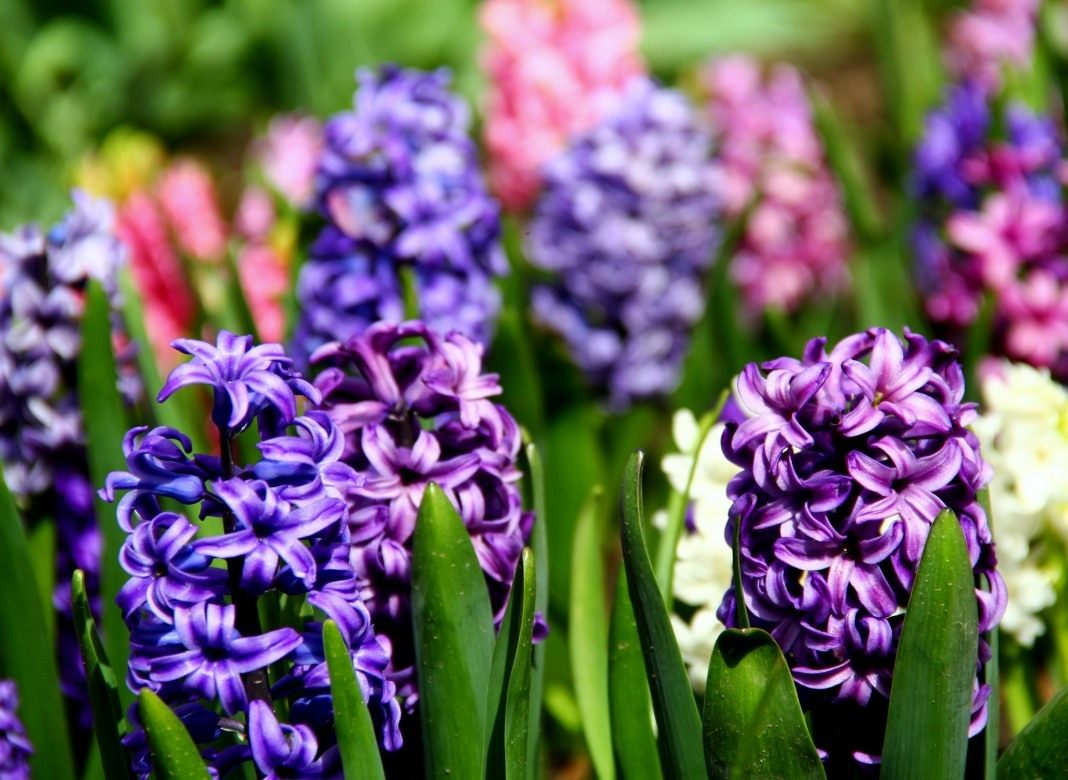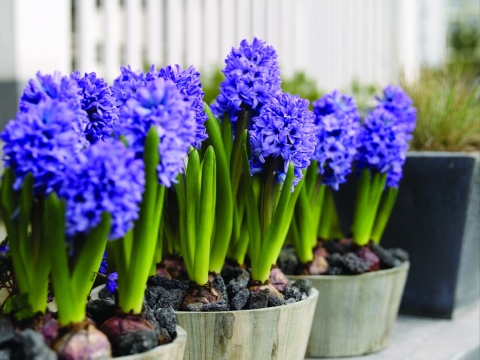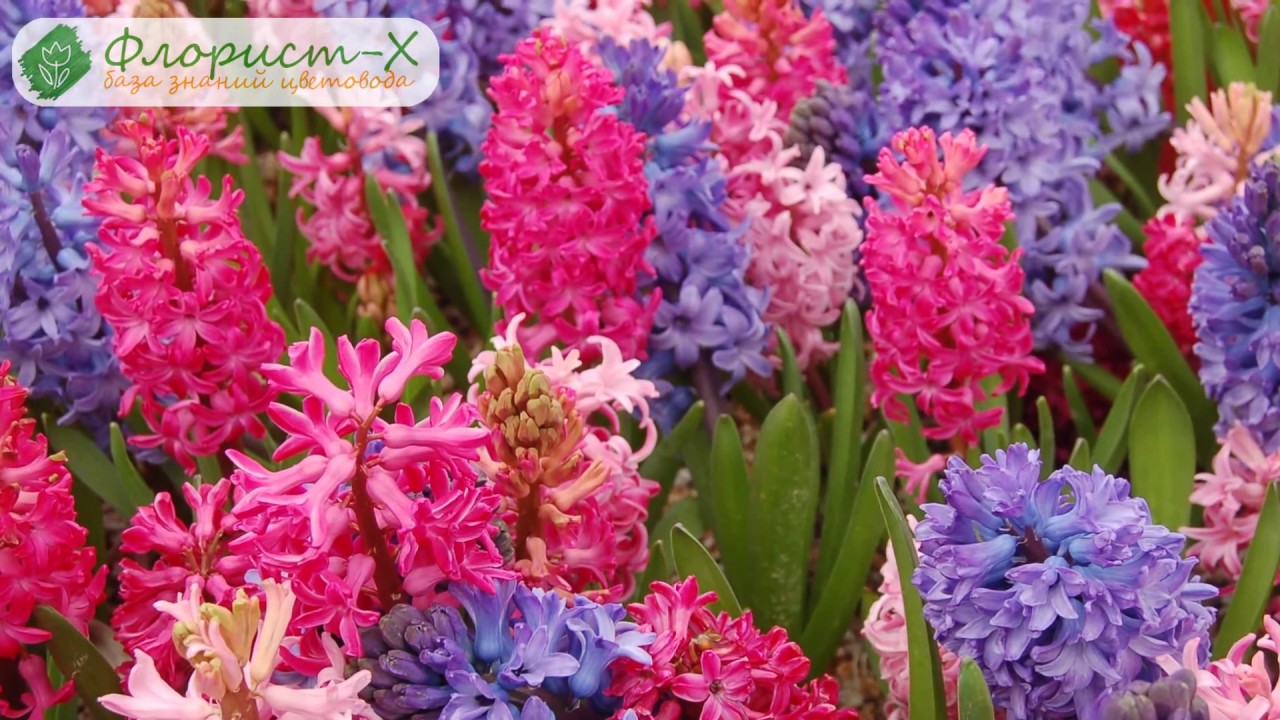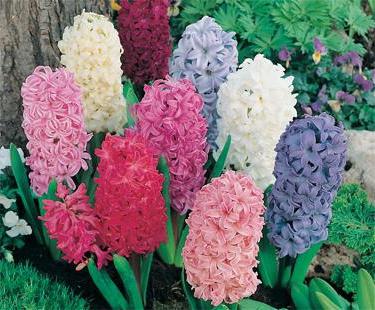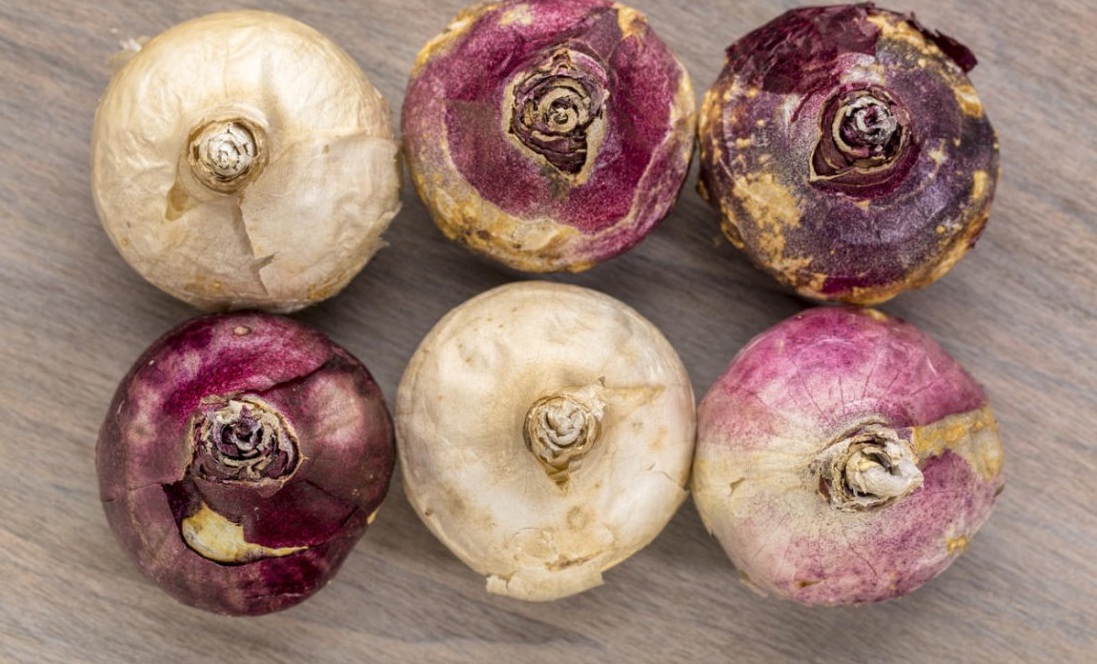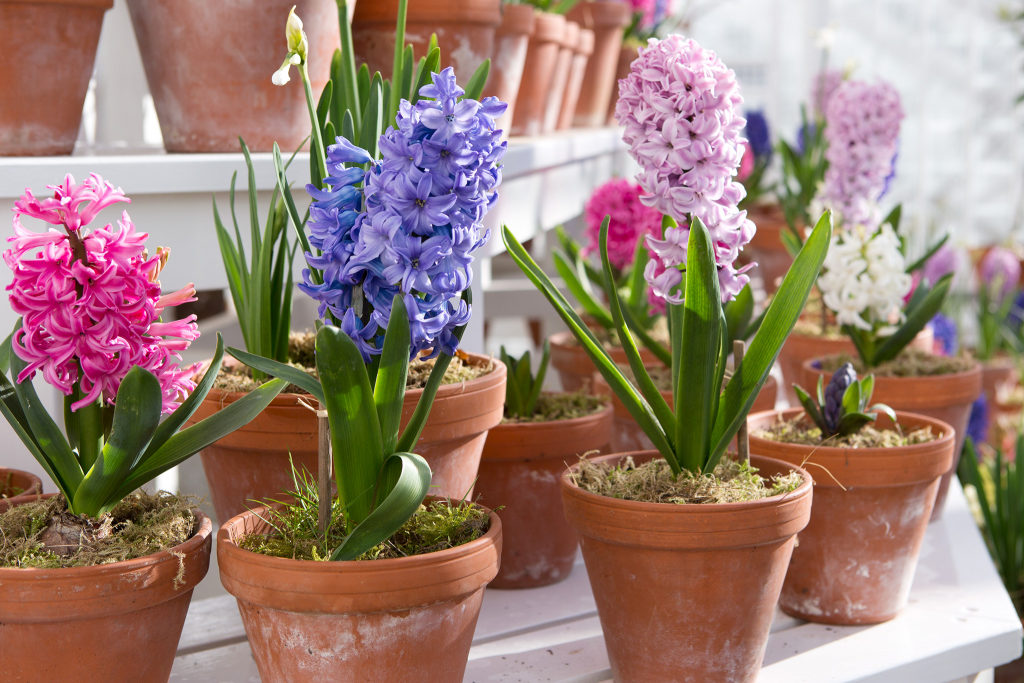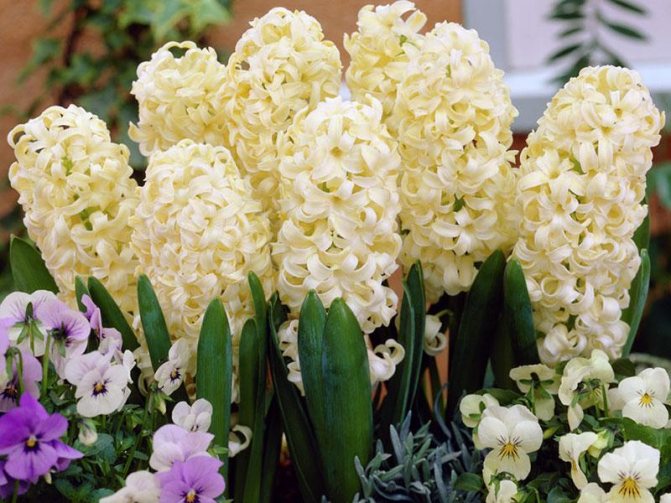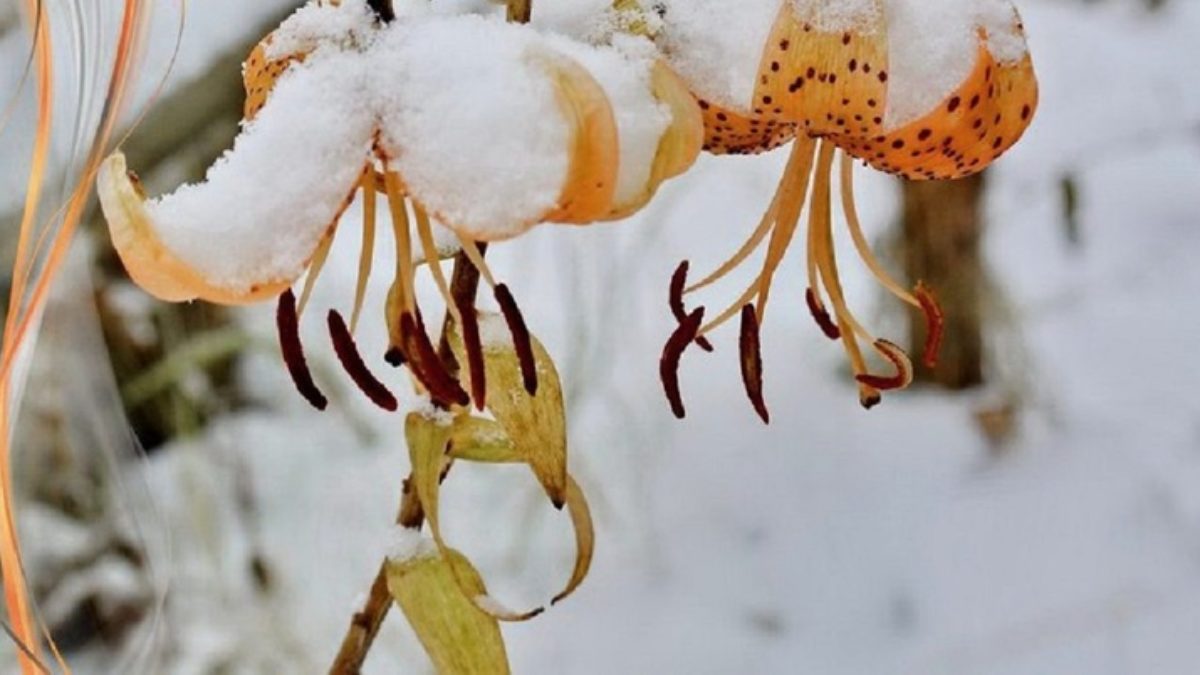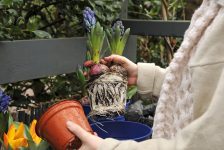When to dig up hyacinths after flowering
The main signal to start digging up the plant, for the gardener is the lodging and complete drying of the foliage of the hyacinth. This happens, depending on the region, from mid-June to July.
In regions with early spring (south of our country, middle lane), hyacinth bulbs are dug out at the end of June, about 50 days after flowering. In the Urals and Siberia, work is delayed by 2-3 weeks.
It is also recommended to dig out the bulbs for plants that have not bloomed. The lack of hyacinth flowering indicates a violation of agricultural technology or disease. Hyacinth does not bloom:
- if in the previous summer the plant was not dug out of the soil and went into the winter weakened;
- the bulb is damaged by pests or rot;
- the hyacinth is planted too deeply, and the sprout has spent energy on germination, to the detriment of flowering.
To transfer the hyacinths to a new site and divide the overgrown curtains, the plants are dug out at the time indicated above.
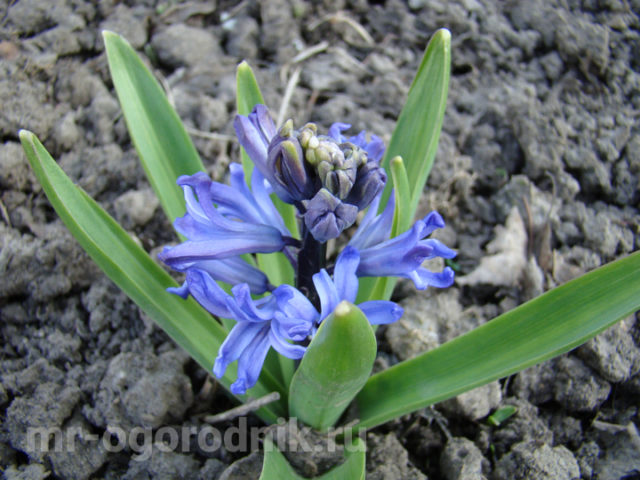
Do I need to dig up hyacinths for the winter?
In regions with severe winters (Ural, Siberia, northern Russia), even with insulation, hyacinth bulbs can freeze out. In addition to cold, flowers are threatened by mice, rodents love to feast on juicy bulbs of hyacinths. It is better to dig up the flowers and store the planting material in storage until spring.
Terms of harvesting tubers
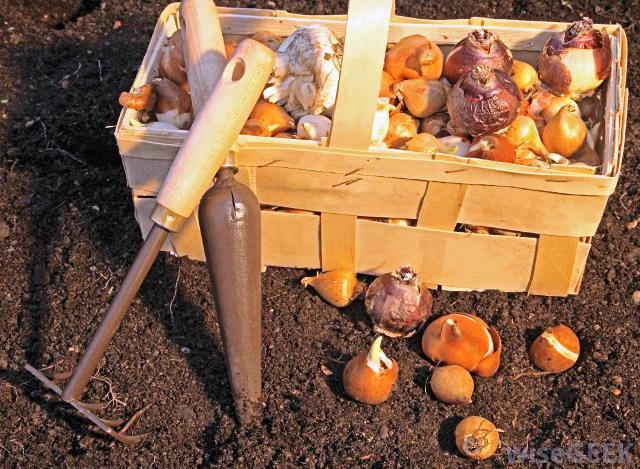
There is no exact date for harvesting tulip bulbs. The choice of a specific number depends on many factors:
- climatic features of the area;
- the readiness of the bulbs for harvesting;
- weather conditions;
- early maturity of the variety.
Only taking into account all the moments, they choose the optimal time.
Tulip bulbs are planted in open ground in spring and autumn. The second method is often chosen.
Date selection by region
For different climatic regions, the timing of harvesting tulip bulbs will differ. Depending on the region, the following deadlines are adhered to:
- in the southern regions, they begin harvesting bulbs from the beginning of June;
- for the middle lane, the optimal time is late June - early July;
- in the northern part, tulips are dug up only at the end of July.
More accurate dates depend on the condition of the ground part, as well as on the early maturity of the variety.
Determination of terms by appearance
Determining whether the bulbs are ready for digging will inform the appearance of the unearthly part. After flowering, tulips enter a dormant stage. The color of the leaves fades, they turn yellow and gradually dry.
Such signs signal the readiness of the bulbs, they have already collected all the nutrients. The ground part must not be allowed to dry completely. If it falls off, it will be difficult to find the nests of the bulbs. You can start digging tulips from the moment when 1/3 of the foliage is dry.
Harvesting the bulbs early will prevent them from accumulating the right amount of nutrients. In the next season, this will affect the development of leaves and flowers.
When to dig out according to the lunar calendar
The influence of the phases of the moon on plants has been known for a long time. If you carry out agrotechnical work in accordance with the lunar calendar, then the flowering will be beautiful, and the plants will be healthy.
You can dig tulips in 2020 on auspicious days determined by the lunar calendar:
- June - 23, 26-30;
- July - 2, 6, 9-10, 14, 17-18.
If you miss the favorable numbers, you can carry out the procedure at any other time. Astrologers recommend avoiding only the New Moon and Full Moon periods.
Favorable weather conditions
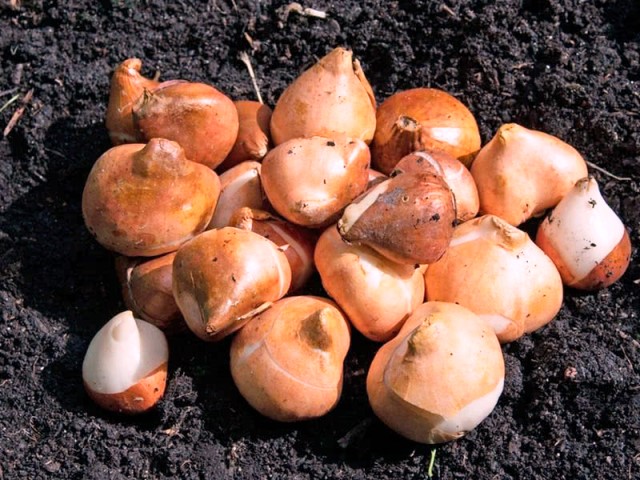
If the bulb is young, the bud must be broken off until it opens. This point should not be ignored, because all nutrients will be spent on ensuring flowering, and not on the development of the underground part. At the same time, there must be at least 2-3 leaves on the stem, otherwise photosynthesis will not be ensured.
A dry, cloudy day is chosen for digging out the culture. The soil should dry out during this time. Excessive moisture is harmful to plants. If the digging time is coming to an end, and the weather does not stabilize, it rains, the bulbs will have to be dried additionally.To do this, lay out the planting material on newspapers or fabrics indoors, and keep it in this form for about 1 week. It is impossible to ignore this moment, the risk of rotting the tubers increases.
If the bulbs are excessively waterlogged and soft to the touch, their condition should be monitored. Probably, the spores of the fungus are under the scales. It is better to carry out a preventive treatment using fungicides.
Recommendations
As we have seen, perennial hyacinth tubers need careful maintenance. Consider a few more nuances associated with digging and storing these plants.
A sharp drop in temperature. When storing the bulbs, the correct temperature is required for the stem to form properly. However, you shouldn't go too abruptly to 10 ° C to keep the plants healthy. If the temperature change is made gradually, then the hyacinth will become more resistant to frost, which will allow the tubers to remain in the soil for one season.
Mold. If the storage rules are violated (high humidity), mold may appear on the bulbs
This is why it is imperative to regularly look through the boxes of stored bulbs and discard spoiled seeds to prevent mold from spreading to others. After you need to process the rest of the fruits with potassium permanganate.
Kids
After you dig up the bulbs, they need to be peeled.
But this should be done very carefully so as not to damage the hyacinth fruit itself, as well as its children (small bulbs are formed after flowering). Small onions need to be separated, washed and treated with manganese
After they need to be planted in pots at home and looked after, ensuring regular watering and feeding. After 3-4 years, the tubers will gain a normal volume, and they can be planted in open ground along with other hyacinths.
Treatment. As mentioned earlier, hyacinth bulbs need to be processed if they are with infected specimens. Although it is possible to carry out disinfection for prophylaxis. After the bulbs have been washed and cleaned, they should be soaked in hot water (no higher than 50 ° C) for 10 minutes. Then treat with a solution of karbofos (leave for 30 minutes) or manganese (5 grams of potassium permanganate per 10 liters of water).
Speed up the process. If you want to speed up the drying process of the bulbs, then simply increase the temperature in the first and second periods by 5 - 7 ° C.

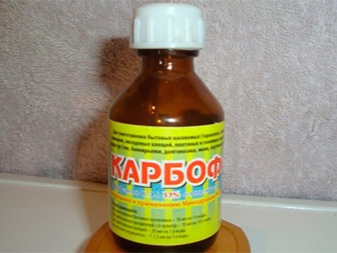
See below for tips on digging and storing hyacinth bulbs.
Where to plant hyacinths
For good growth of any flower, you need to know what place it is best to plant, taking into account lighting and soil. Hyacinth is no exception. Therefore, you need to know what place in the garden you need to choose for planting it.
Hyacinths should be planted in dry areas with loose, light soil, well lit by the morning and evening sun. You can add some coarse dry sand to the soil.
Hyacinths love humus, but there is no need to put manure into the ground, hyacinths do not tolerate this fertilizer. You can also add peat to the soil. Clay soils, which do not allow water to pass through well, should be avoided.
It is advisable that the place for hyacinths is not blown by a strong wind, because these flowers do not like drafts. Cold winds, especially at the beginning of flowering, can be detrimental to these flowers.
You can try to plant hyacinths in partial shade, for example, under the crown of a tree or next to shrubs, but you should not plant hyacinths in the shade of a house or a fence, because these flowers do not like a thick shade.

Just do not plant hyacinths too close to trees, because their large roots will take from the soil a lot of substances that hyacinths need so much for decorative flowering.
It is desirable that the site is not completely flat, but with a slight slope, and rainwater can drain without damaging the bulbs. Otherwise, the flowers may die.
If you choose the right place for the hyacinths, taking into account their preferences, then you can do not dig up the bulbs 3-4 years.Hyacinths will grow beautifully and decoratively bloom profusely.
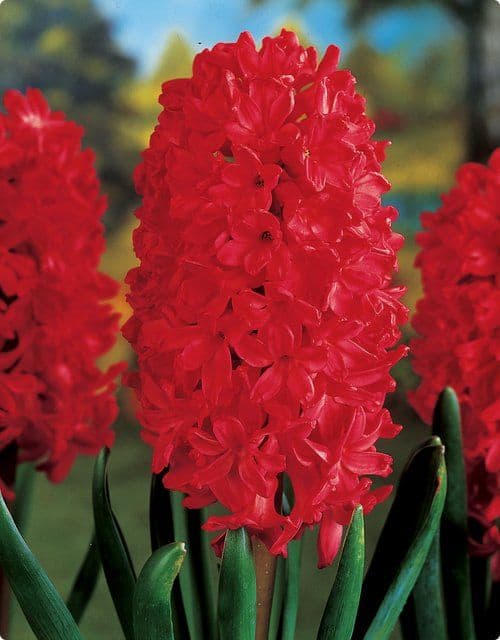
When to dig up hyacinths
Hyacinths must be planted and dug up every year, otherwise it will not be possible to preserve the varietal characteristics of the plants. In the conditions of the middle lane, for the normal formation of vegetative organs and inflorescences of the next year, it is advisable to dig out the bulbs of hyacinths annually. Without this, already in the second year, flowering weakens, and then it completely disappears.
It is best to dig up hyacinths in late June or early July, when the leaves turn yellow. The dug out bulbs are carefully cleaned from the ground, the leaves are cut off and dried for 2-3 days. Then they are cleaned of excess scales, roots, growths on the bottom, large new bulbs (children) are separated and stored. The total storage time is about 95 days. Of these, it is advisable to store the bulbs for 2 months at a temperature of + 25 ... + 26 ° С, then a month at + 17 ° С. At the same time, the humidity in the room where the bulbs are stored should not be too low so that they do not dry out. To maintain moisture, you can spray the bulbs with water from time to time.

In the photo: bulbs of dug hyacinths.
Favorable days according to the lunar calendar of the gardener and gardener of 2020 for digging hyacinths: 6, 11-13, 16-18 (the most favorable days), June 28-29, July 10-15.
Hyacinth preferences
First of all, you need to understand what exactly they love and what they don't like these flowers.
Hyacinths prefer:
- warm sunny areas of the garden, located on the hills;
- abundant hydration during the entire flowering period;
- light loose nutrient soil;
- thorough weeding, especially near roots that like to "breathe".
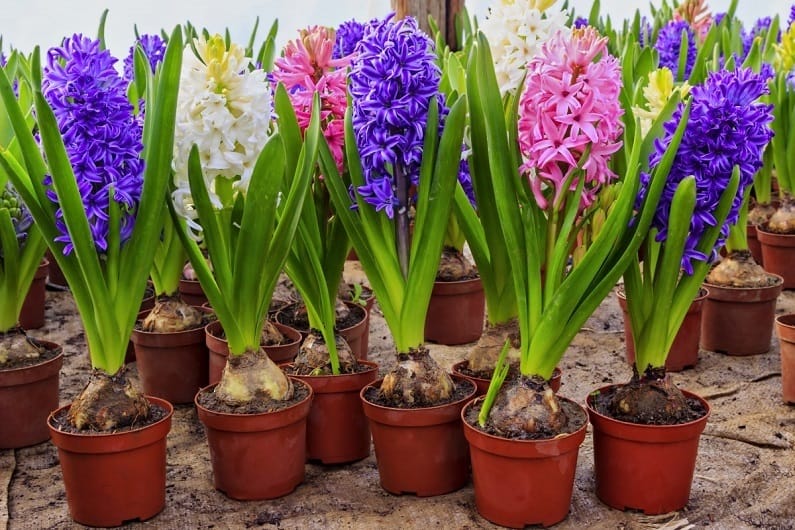
Hyacinths do not tolerate:
- too wet, swampy land, as the bulbs begin to rot;
- too thick shade - flowering becomes less abundant, in addition, if hyacinths grow in the shade, you will have to dig out the bulbs every season;
- storage of dug out bulbs in a cold room - then they may not sprout;
- planting in insufficiently heated soil - if hyacinths grow, there is a high risk of not flowering.
Taking into account the preferences of hyacinths, which naturally grow in warm and humid climates, they need to create favorable conditions for growth.

Why dig up tulips after flowering
In the conditions of our flower beds, tulip bulbs (even during one season) tend to deepen and, if we do not choose them from the ground, then every year they will go deeper and deeper. It will be difficult for the sprouts to make their way up from the depths - as a result, the bulbs will simply rot in the ground, not even leaving the children. The spring flower bed will be empty ...
There is another reason why tulips need to be dug up. After flowering, the bulbs should form a new flower arrow during the dormant period. The main requirement is that at this time they must be at a temperature not lower than 25 ° C. But the deeper, the lower the soil temperature. The farther north tulips grow, the more difficult it is to provide them with the desired temperature at depth.
Thus, there are at least two reasons for picking tulips from the soil after flowering:
- avoid natural burial of the bulbs;
- ensure the storage temperature is not lower than 25 ° C to form a full-fledged flower arrow.
If you want to admire the large flowers of tulips, it is recommended to remove the bulbs from the ground every year.
This is one of the main methods of tulip cultivation.
Leaving the bulbs untouched in the ground, we deliberately contribute to the grinding of flowers, since several children form next to one bulb, which will also sprout in the spring. We will get a bunch of tulip sprouts that will interfere with each other's growth and development, they will also lack food. As a result, every year we will receive flowers in the flowerbed smaller and smaller. In addition, remaining in the ground, tulip bulbs accumulate diseases, and the next year they will bloom later than usual.
For the best formation of the flower arrow after flowering, immediately cut off all the peduncles, do not let the seed box ripen.
I am often asked whether it is necessary to extract tulips from the ground that have been planted in special baskets for bulbs? Indeed, in this case, the bottom of the plastic mold will not allow the bulbs to deepen.
That's right, deepening will not occur, but without picking out the bulbs from the ground, which over time become overgrown with children, you risk losing abundant flowering - the flowers will become smaller, their number will decrease, and not grow.
Planting tulips and other bulbs in plastic bulb baskets makes digging much easier and faster. All bulbs - large, medium, small - are in one place, it is impossible to miss them, leave them in the ground.
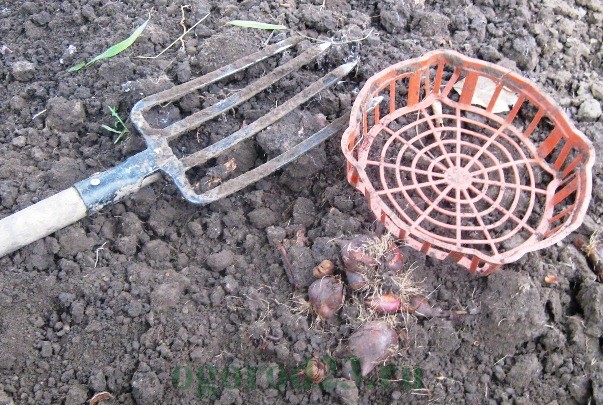
Storage methods
It is easy to determine that the planting material is ready for the last stage: if the old corm separates from the new one without any problems, you can pack the seed gladioli in storage containers.
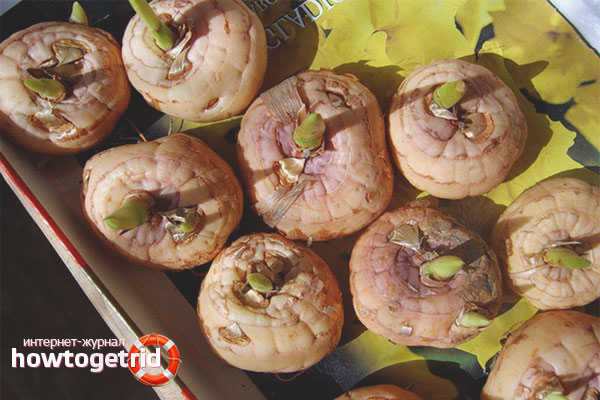
Method 1
Use cardboard boxes or wood, you can stock up on plastic containers. The main thing is that they have holes for ventilation.
- Wrap each onion with a piece of newspaper or blank paper.
- Place in boxes. To prevent pests, pour naphthalene into the container. An alternative is 3-4 cloves of peeled garlic.
- If the basement is damp, put the box of gladioli in the refrigerator. The bottom shelf for storing fruit will do.
Method 2
Put the bulbs wrapped in newspapers in a vegetable net. Store in a basement or refrigerator at + 5–8 degrees, and humidity no higher than 85%. Add a few cloves of peeled garlic to ward off pests.
Method 3
Remove the top husk from the bulbs. Warm up the paraffin wax, and immerse each in a liquid product. When planting, do not wash off the protective film.
Typical mistakes
- Do not remove the top husk from the bulbs. It protects the planting material from drying out. An exception is when processing with paraffin.
- You cannot store gladioli in plastic bags, even with holes. They do not allow air to pass through well, and condensation accumulates inside.
- Sprouted planting material must be moved to a cool room with diffused light.
Harvesting and storing gladioli is not as troublesome and difficult as it might seem to beginner gardeners. It is enough to remove the bulbs from the ground in a timely manner, dry and process them correctly, and in the spring they will delight you with friendly shoots and beautiful flowers.

